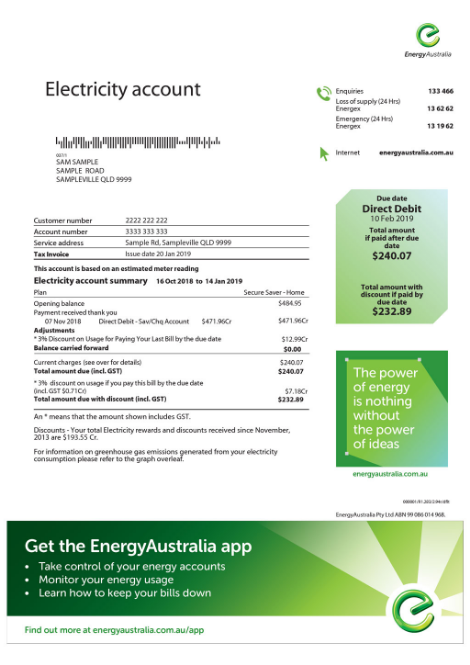Contents
Compare the Average Electricity Bill
These days, the cost of everything has gone up. But nothing has been more frustrating than the soaring costs of a basic need: electricity.
We understand how you feel because at Electricity Monster, we’ve been helping Aussies like you find a fair deal on your power. Phone us at 1300 232 848 NOW and our team of energy experts will help you find the best deal we have available. If you feel like you're overpaying for power, there's no better time to switch to a better deal. Call us today to learn more.


What is the Average Electricity Bill in Australia?
The national average electricity bill across Australia is $1,645 as of December 2021.
Below you will find the annual average electricity bill for each individual state. The following data is taken from AEMC's Residential Electricity Price Trends 2021. If you're paying more than your state's average, you need to phone us at Electricity Monster now as you might be overpaying on your current plan.
The following average electricity bills are taken from our customer satisfaction ratings research published in February 2022. The costs reported include households of all sizes and should only be considered as a general guide.
| State | Average Annual Electricity Bill |
|---|---|
| National Average Electricity Bill | $1,645/year |
| Victoria | $1,290/year |
| New South Wales | $1,253/year |
| Queensland | $1,226/year |
| South Australia | $1,742/year |
| ACT | $2,004/year |
*The figures above are from the Australian Energy Market Commission (AEMC), Residential Electricity Price Trends 2021, Final report, 25 November 2021. These figures reflect the default energy usage of a 2 person household in each state.
A Breakdown of the Average Bill
From the table above, we can see that ACT has the highest electricity bill on average across Australia. To put that into perspective, ACT residents are paying a whopping 39% more than Queensland residents.
While Victorians can be pleased about having a low average, these numbers don’t tell the full story. Let’s dig deeper.
According to the latest Victorian Energy Market Report, the state’s economic regulator clearly shows that Victorian residents are needlessly overpaying for their energy bills due to brand loyalty and a striking preference towards large-name electricity providers.
Does this sound like you?
YOUR government has said two million of your fellow Victorians could be paying less for their energy. How confident are you that you aren't one of them? Enough to take the risk by not spending 5 minutes to check?
Economic analysis and research into customer preferences by the Victorian government have shown that Victorians place their trust in larger, more well-known energy retailers.
But here’s the catch. In doing so, these customers may be missing out on potential savings, incentives, and ultimately a lower energy bill.
When it comes down to it, comparing retailers is a choice that you have as an energy customer. We can’t stress enough how important it is to shop around before committing to the first electricity provider you see.
This is where we can help. Electricity Monster’s 100% free service helps compare prices within our network of providers to help you find you a sharp rate.
Even if you’re unsure whether or not you want to switch to a new provider, give us a call anyways. Our comprehensive one-on-one consultation with one of our energy experts is designed to help you explore your options and show you how much you could save when you switch to one of our partnered retailers.
Stop stressing about your energy bill and focus on what matters most – saving money.
Victoria – $1,290/year – 22% lower than the national average
Based on AEMC’s findings, a Victorian’s average annual electricity bill in Melbourne amounts to roughly $1,290 per year.
As discussed earlier, Victorian residents have a tendency to sign up with retailers that are bigger and well-known.
This might seem logical if you can ill afford to spend countless hours comparing every individual plan to find one that provides the best value. However, picking and choosing a retailer based on the name alone can lead to missed savings.
Don’t waste your time shopping around. Instead, let Electricity Monster be the one-stop solution to your energy needs. We compare rates and plans within our network of energy and gas providers to find you a fair deal. It’s 100% free and easy. Phone us at 1300 232 848 today and explore your energy options the right way.
| Retailer | % Below VDO* | Price/year (Est.) |
|---|---|---|

Flexi Plan
|
5% | $1,228 |

AGL Value Saver
|
4% | $1,241 |

Origin Go Variable
|
2% | $1,268 |
New South Wales – $1,253/year – 24% lower than the national average
AEMC’s 2021 financial report states that NSW residents in Sydney, Newcastle and Central Coast are paying $1,253/year for their electricity on average.
On paper these figures look decent, especially when compared to other states and the national average. But the data doesn’t account for the thousands of households still overpaying for their electricity.
It makes sense to shop around for the best deal available. While you might feel content with what you’re paying, it’s always recommended to at least see whether or not there is a better deal available that offers you the same type of plan but at a lower rate. But you may never know unless you take the initiative to start the comparison shopping process.
If you’re hard on time or just don’t want to deal with the stresses that come with comparing retailers, we can help simplify this process. At Electricity Monster, we don’t just aim to find you a better deal within our network of energy providers, we offer a 100% free comprehensive service designed to help you get connected fast. Give us a call at 1300 232 848 today.
| Retailer | % Below DMO* | Price/year (Est.) |
|---|---|---|

AGL Value Saver
|
6% | $1,421 |

Flexi Plan
|
5% | $1,436 |

Origin Go Variable
|
4% | $1,451 |
Queensland – $1,226/year – 25% lower than the national average
So what’s the average annual electricity bill for Brisbane, Gold Coast and Sunshine Coast residents? According to AEMC, the average electric bill in Queensland is $1,226.
Queensland currently has the lowest average out of all five states according to the latest data by AEMC, by a significant 25% margin. However, how does your current electricity bill compare to the national average, or even the Queensland average?
If you’re one of the many Queensland residents that are paying higher than the average, we have the solution for you. Call Electricity Monster. We work with a network of trusted electricity and gas retailers that offer a wide range of plan options that may offer more value than what you’re currently paying.
Don’t wait, phone us at 1300 232 848 today and we’ll work to find you a fair deal for a fair price. We’re 100% free and easy to use.
| Retailer | % Below DMO* | Price/year (Est.) |
|---|---|---|

Origin Go Variable
|
3% | $1,571 |

AGL Basics
|
0% | $1,620 |

Flexi Plan
|
0% | $1,620 |
South Australia – $1,742/year – 6% higher than the national average
South Australians have to fork out $1,742 on average for their annual energy bills according to AEMC’s latest report. Needless to say, the average bill in Adelaide is higher than the national average. But that doesn’t mean you have to stick to your current plan.
Did you know that you can freely choose your electricity provider and even switch from your current one? With the market being as competitive as it is, you may be able to secure a better rate and even potentially save money in the long run. After all, who wants to pay an absurd amount for energy?
We understand your uncertainty and frustration, which is why we’re here to help. Our energy experts work with a network of retailers in the SA market to find you a fair deal. If you’re looking for a better rate, look no further. Call us today at 1300 232 848 and we’ll work with our partners to find you a fair plan at a fair price.
| Retailer | % Below DMO* | Price/year (Est.) |
|---|---|---|

AGL Value Saver
|
4% | $1,767 |

Origin Go Variable
|
2% | $1,803 |

Flexi Plan
|
0% | $1,840 |
ACT – $2,004/year – 22% higher than the national average.
According to AEMC’s latest data, ACT comes in as another state with high costs. With the average bill in Canberra being 22% higher than the national average, it’s no wonder energy customers are looking for more budget-friendly options.
If you feel like you’re overpaying for your energy, one way to mitigate costs is by limiting your energy usage. However, if you’re stuck with a high rate or an expensive energy plan, at the end of the day you might not see that much of a difference on your bill.
Instead, consider shopping around and making the switch to another retailer. In ACT, the market is filled with energy providers that want your business – meaning you have plenty of options to choose from. The only problem is which provider is going to offer you a better deal?
This is where we can help. At Electricity Monster, we know how you feel about overpaying for electricity and gas. It’s stressful, frustrating and takes a toll on your finances over time. Give us a ring at 1300 232 848 and we’ll guide you through all of the plans we have available to find you a fair rate at a fair price. Don’t wait, call us now.
| Retailer | % Below DMO* | Price/year (Est.) |
|---|---|---|

Origin Go Variable
|
6% | $1,942 |

Flexi Plan
|
1% | $2,047 |
What is Affecting My Electricity Bill?
Two major factors impact the cost of your electricity: Energy Usage and Energy Prices. Let’s take a closer look at these two components.
Electricity Usage
Your energy usage is dependent on the number of people residing in your household. It makes sense that smaller residential properties that house 2 or 3 people are more likely to have a lower electricity bill per month than a larger household.
More people in a home generally means:
- More rooms and square footage, which means more places to cool or heat,
- More energy consumption from multiple electronic devices running at the same time,
- More cooking and refrigerator/freezer use,
- More heated water for showering, etc.
However, your energy usage can also depend on other factors. For instance, how frequently you use certain appliances such as washing machines, televisions, or gaming consoles. These can quickly rack up your energy bill, especially if they’re not energy-efficient.
Electricity Prices
How much you pay for your power is another critical factor.
When was the last time you switched electricity providers?
Are you truly happy with your current provider or are you just settling? Perhaps you just don’t have the time to shop around and compare rates. There are numerous factors but it’s important to understand that switching providers may end up lowering your electricity bill per month.
To top it off, if you’ve been with the same provider you could be incurring the dreaded loyalty tax.
If you’re on a sharp rate, your bills should typically be lower than households on high electricity rates. If not, you could be hemorrhaging money without even knowing it. If you’re not happy with your current electricity deal, phone us at 1300 232 848, and we’ll help sort you out with a fair rate. We’ll factor in your energy usage and help you find a better deal within our network of partnered retailers to match your needs.
How Can I Lower My Energy Bill?
Electricity isn’t cheap – especially when you rely on it for your everyday needs. However, making a few small changes to the way you use energy could ease the pressure on your household budget.
This section covers two crucial steps you need to consider when it comes to electricity usage.
Understand How Much Energy You Are Using
The first step is pretty straightforward.
What appliances, electronics, and other products are running in your household right now?
Take a look around and see what you currently have powered on while reading this. A quick 15-minute walkthrough of your household can uncover a number of unnecessary electronics or appliances that are actively draining energy. Your energy consumption, as you already know, is the driving force behind high electricity bills.
Take the time to switch off your appliances or electronics when they’re not needed, or even unplug them. In some cases, certain devices will continue to use energy when plugged in – even when they’re on standby or not in use.
Replace Energy Inefficient Appliances
Appliances in your laundry, kitchen, bathroom, and even your living room can account for a good portion of your energy consumption.
While it does require an investment, replacing your old appliances may save you hundreds, if not thousands of dollars over their lifetime. Take the time to check your household and prioritise the oldest appliances.
Keep in mind that it would be wise only to purchase what you can afford. After all, what good is it to buy new appliances if it’s only going to sabotage your financial wellbeing?
Compare Plans and Consider Making the Switch
No matter how much effort you put into lowering your energy bill, if you’re stuck in a plan with a high rate you’re already at a disadvantage financially. As an energy customer, you’re encouraged to find the best deal available.
It makes sense to shop around and compare plans because if you’re in one of the states that are boasting a higher than average electricity bill, you could be overpaying.
So what’s the first step?
Give us a call. Comparison shopping can be mind-numbing and equally frustrating to do on your own – especially if you’re looking for the best deal. And, since price is ultimately the deciding factor in which retailer you choose, you’ll want to consider incentives, discounts, and other benefits before making your decision.
This is where we can help.
At Electricity Monster, our network of partnered electricity and gas providers offer a wide range of plans to choose from. Our comprehensive service is 100% free and easy to use. We’ll help you get connected fast and to a fair deal, without the hassle of shopping around. Click on the link below to get started.
How Can I Tell That My Bills Are Average?
Keen to find out how your energy bill compares to similar households in your area? Your latest electricity bill may offer some helpful insight.
This information is typically found on your energy bill. It shows the customer their daily household consumption and how it compares to other similar households in the same region.
The image below is an example of an electricity bill from EnergyAustralia.

How Can I Get A Better-Than-Average Electricity Plan?
By now you’ve probably compared your current electricity bill to your residing state. How does yours compare? Are you paying more than you think you should? It’s possible you could even be paying less than the state average.
But why settle for “average” when you could get a better-than-average electricity deal?
It’s time you saved money on your energy. At Electricity Monster, we’re your solution to your energy and gas needs. We offer a comprehensive service for people like you who are tired of paying more than what they should. Our process is fast, fair, and 100% free to use. Give us a call today and see how we can help.
Ready to Make the Switch?
If you’re tired of overpaying on your electricity, it makes sense to shop around and compare rates. With the average electricity bill varying at such a wide margin from state to state, there’s a chance that another retailer can provide you with more value and a better rate than what you’re currently paying.
And let’s be completely honest, who would say no to a lower energy bill?
The downside to comparison shopping however, is the amount of time it takes to research every single energy provider currently servicing your region – which can be excessive and equally frustrating.
The solution is Electricity Monster. At Electricity Monster, we’re partnered with a network of trusted electricity and gas retailers. We take the guesswork out of comparison shopping by finding you the best rate we have available. Best of all, our service is 100% free, fast, and easy. Give us a call today and let’s work together to find a cost-effective solution to your energy woes.
For more info on the best plan in your state, pop in your details in the form above or give us a call on 1300 232 848 today!
Other Reads You Might Like
Disclaimer
Important Points to note are:
- This data is accurate as of 01/03/2022.
- Average Electricity Bill costs are based on the AEMC, Residential electricity price trends 2021, Final report, 25 November 2021.
- The Big 3 Energy Providers’ best plans are calculated using the AEMC, Residential electricity price trends 2021, Final report, 25 November 2021 main assumption’s kWh usage.
- All plan images have been captured off the Energy Price Fact Sheets taken from the respective retailers’ websites.
- The information in this blog cannot substitute for legal advice. No financial decisions should be made based on information from this blog.
- The plans displayed may be different than those advertised.
- The plans offered on this page may not be available in our call center.
- Get Best Offer’ is indicative of the best offer available in our database from our partners
Get a $50* Coles or Woolies Voucher
When You Call & Switch Today
- Compare Providers
- 100% Free Service
- Brokered Over 150,000 Deals

Get a $50* Coles or Woolies Voucher
When You Call & Switch Today
- Compare Providers
- 100% Free Service
- Brokered Over 150,000 Deals

Get a $50* Coles or Woolies Voucher
When You Call & Switch Today
- Compare Providers
- 100% Free Service
- Brokered Over 150,000 Deals

Benjamin Tom
Benjamin Tom covers the retail energy market, with a focus on electricity, solar, and Internet. His interests include helping people navigate the complexities of the energy market while saving money on their power bills.




